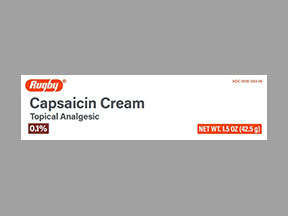
Capsaicin Pain Relief Coupons & Savings Card – Discount Prices from $12.38
This medication is designed to alleviate minor muscle and joint aches, including conditions like arthritis, backaches, and sprains. Capsaicin functions by reducing the levels of substance P, a natural compound in your body that transmits pain signals to the brain.
Our coupons are free to use. Before paying, show the pharmacist your Capsaicin Pain Relief savings card to get your free discount. Use our filters below to edit the prescription box to match your needs. The Capsaicin Pain Relief prices will update based on your prescription needs. Above our Capsaicin Pain Relief coupons, you can change your location to see pharmacy prices and costs in other areas. We're here to help you buy Capsaicin Pain Relief at the lowest price with our prescription discount card.
My prescription
Edit
42.5GM of 0.1%, Capsaicin (1 Tube)
Select pharmacy

Albertsons
$12.38
COUPON PRICE
Walgreens
$12.49
COUPON PRICECapsaicin Pain Relief savings card
Show this card to your pharmacist
Albertsons
$12.38
BIN
ID
PCN
GRP
011867
LH6450B523
HT
LABH001
Powered by
This medication is designed to alleviate minor muscle and joint aches, including conditions like arthritis, backaches, and sprains. Capsaicin functions by reducing the levels of substance P, a natural compound in your body that transmits pain signals to the brain.
Our coupons are free to use. Before paying, show the pharmacist your Capsaicin Pain Relief savings card to get your free discount. Use our filters below to edit the prescription box to match your needs. The Capsaicin Pain Relief prices will update based on your prescription needs. Above our Capsaicin Pain Relief coupons, you can change your location to see pharmacy prices and costs in other areas. We're here to help you buy Capsaicin Pain Relief at the lowest price with our prescription discount card.
More prescriptions for pain
coupons from$20.16Save 44%
coupons from$25.44Save 75%
coupons from$9.59Save 59%
coupons from$236.20Save 72%
coupons from$328.31Save 16%
coupons from$390.96Save 58%
coupons from$1209.62Save 17%
coupons from$9.59Save 59%
More prescriptions for pain
Goodsense Aspirin Adult Low St Save 44%coupons from $20.16
Ms Contin Save 75%coupons from $25.44
Non-aspirin Save 59%coupons from $9.59
Meclofenamate Save 72%coupons from $236.20
Apap-caff-dihydrocodeine Save 16%coupons from $328.31
Xtampza ER Save 58%coupons from $390.96
Orphenadrine-aspirin-caffeine Save 17%coupons from $1209.62
Pain Reliever Save 59%coupons from $9.59
Our coupons are free to use. Before paying, show the pharmacist your Capsaicin Pain Relief savings card to get your free discount. Use our filters below to edit the prescription box to match your needs. The Capsaicin Pain Relief prices will update based on your prescription needs. Above our Capsaicin Pain Relief coupons, you can change your location to see pharmacy prices and costs in other areas. We're here to help you buy Capsaicin Pain Relief at the lowest price with our prescription discount card.
Capsaicin Pain Relief dosage forms
Use our Capsaicin Pain Relief 42.5GM of 0.1% coupon with prices from $17.08 for 1 Tube. You can also use our Capsaicin Pain Relief 42.5GM of 0.1% coupon with prices from $25.15 for 2 Tubes. We have a Capsaicin Pain Relief 42.5GM of 0.1% coupon with prices from $33.23 for 3 Tubes.
Dosage Quantity Price from Per unit 42.5GM of 0.1% 1 Tube $17.08 $17.08 42.5GM of 0.1% 2 Tubes $25.15 $12.57 42.5GM of 0.1% 3 Tubes $33.23 $11.08
| Dosage | Quantity | Price from | Per unit |
|---|---|---|---|
| 42.5GM of 0.1% | 1 Tube | $17.08 | $17.08 |
| 42.5GM of 0.1% | 2 Tubes | $25.15 | $12.57 |
| 42.5GM of 0.1% | 3 Tubes | $33.23 | $11.08 |
Capsaicin Pain Relief Warnings
Capsaicin and zucapsaicin share similar properties. Therefore, it is important to avoid using any medications that contain zucapsaicin while you are using capsaicin.
Capsaicin Pain Relief Side Effects
Common side effects:
- warmth at the application site
- stinging at the application site
- burning at the application site
- coughing
- sneezing
- watery eyes
- throat irritation
Less common but important to monitor:
- blistering at the application site
- swelling at the application site
- increased or unusual pain
Serious side effects:
- severe allergic reaction
- rash
- severe itching or swelling, especially on the face, tongue, or throat
- severe dizziness
- trouble breathing
Capsaicin Pain Relief Interactions
Interactions with high risk of serious adverse effects and should be avoided:
- zucapsaicin
